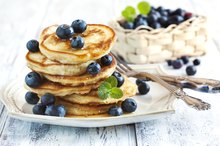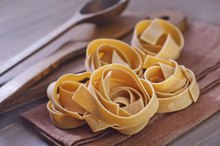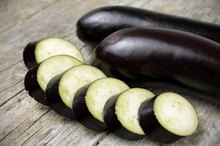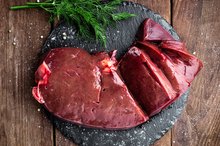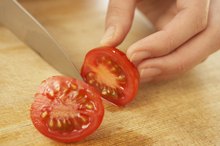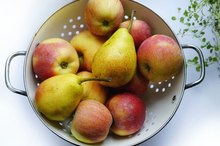Food Menu for People with Gout
Gout is a condition characterized by the deposit of uric acid in the joints. People with gout may experience a sudden onset of arthritis-like symptoms, including swelling, redness and warmth in one or more joints. Although gout can be caused by a number of conditions, it is often exacerbated by the consumption of foods high in purine. Individuals who have been diagnosed with gout should incorporate low-fat dairy, fresh fruits and vegetables and whole grains into their diets on a regular basis.
Low-Fat Dairy Products
In "Nutrition Therapy and Pathophysiology," Marcia Nelms et al. report that low-fat dairy products can be beneficial for individuals who have been diagnosed with gout. In addition to reducing the pain and swelling associated with the condition, low-fat dairy products may prevent its development altogether. In fact, the National Institute of Arthritis and Musculoskeletal and Skin Diseases reports that in one study, men who consumed low-fat dairy on a regular basis cut their chance of developing gout by as much as 50 percent. Skim or low-fat milk is an excellent choice for those living with gout, and dairy products that are made from low-fat milk -- including mozzarella cheese and certain types of sorbet -- can also be helpful.
- In "Nutrition Therapy and Pathophysiology," Marcia Nelms et al.
- Skim or low-fat milk is an excellent choice for those living with gout, and dairy products that are made from low-fat milk -- including mozzarella cheese and certain types of sorbet -- can also be helpful.
Fresh Fruits and Vegetables
Buttermilk & Gout
Learn More
People who have been diagnosed with gout should also include a wide array of fruits and vegetables in their diet, reports Nelms et al. A variety of produce can be safely incorporated into the diet of those living with gout, but fruits and vegetables that are high in vitamin C -- such as peppers, cabbage, red potatoes and citrus fruits -- can be especially helpful. These foods likely aid in the management of gout by reducing the production of uric acid, a strong contributor to gout exacerbation, reports the National Institute of Arthritis and Musculoskeletal and Skin Diseases. Consider fresh, not dried, fruits and vegetables to ensure optimal results in the management of this condition.
- People who have been diagnosed with gout should also include a wide array of fruits and vegetables in their diet, reports Nelms et al.
- A variety of produce can be safely incorporated into the diet of those living with gout, but fruits and vegetables that are high in vitamin C -- such as peppers, cabbage, red potatoes and citrus fruits -- can be especially helpful.
Whole Grains
Whole grains should also be part of the food menu for people with gout. As suggested by their name, whole grains are those that remain in their most natural form and have not been stripped of their germ and bran. Foods that are made from whole grains -- such as brown rice, whole oats or bulgur and millet -- are low in purines and high in fiber. According to Nelms et al. in "Nutrition Therapy and Pathophysiology," fiber aids in the treatment of gout by reducing triglyceride levels and assisting in the management of metabolic syndrome. Triglycerides and metabolic syndrome contribute to the develop of gout. Adult men and women should aim for 5- to 8-ounce equivalents of grains each day and consume at least half of those in the form of whole grains.
- Whole grains should also be part of the food menu for people with gout.
- Foods that are made from whole grains -- such as brown rice, whole oats or bulgur and millet -- are low in purines and high in fiber.
Eliminate Foods High in Purine
List of Foods That Reduce Uric Acid
Learn More
While incorporating certain foods into your diet is important in the management of gout, avoiding specific food products is also crucial. The National Institute of Arthritis and Musculoskeletal and Skin Diseases encourages all individuals who have been diagnosed with gout to avoid foods that are high in purines. Although purines can be found in a number of foods, they are most commonly associated with seafood and organ meats, including anchovies, sardines, beef kidneys and brains. Cutting out all alcohol intake is also essential for individuals who are living with gout.
- While incorporating certain foods into your diet is important in the management of gout, avoiding specific food products is also crucial.
- Cutting out all alcohol intake is also essential for individuals who are living with gout.
Related Articles
References
- Nutrition Therapy and Pathophysiology; Marcia Nelms et al.
- National Institute of Arthritis and Musculoskeletal and Skin Diseases: Questions and Answers About Gout
- Foods That Cause Gout: Basics
- U.S. Department of Health and Human Services and U.S. Department of Agriculture. 2015–2020 Dietary Guidelines for Americans. 8th Edition. Published December 2015.
- U.S. Department of Health and Human Services. Gripped by Gout. NIH News in Health. Published February 2014.
- National Institute of Arthritis and Musculoskeletal and Skin Diseases. Gout. Updated April 2016.
- Zhang Y, Chen C, Choi H, et al. Purine-rich foods intake and recurrent gout attacks. Ann Rheum Dis. 2012; 71(9):1448-53. doi:10.1136/annrheumdis-2011-201215
- Fischer E. Ueber die Harnsauer. 1 [On Uric Acid. 1]. Berichte der Deutschen Chemischen Gesellschaft. 1884: 17:328-338. doi:10.1002/cber.18980310304
- Ragab, G., Elshahaly, M., & Bardin, T. (2017). Gout: An old disease in new perspective – A review. Journal of Advanced Research, 8(5), 495–511. doi:10.1016/j.jare.2017.04.008
- Centers for Disease Control and Prevention. Gout. Updated January 28, 2019.
- Zgaga, L., Theodoratou, E., Kyle, J., Farrington, S. M., Agakov, F., Tenesa, A., … Campbell, H. (2012). The Association of Dietary Intake of Purine-Rich Vegetables, Sugar-Sweetened Beverages and Dairy with Plasma Urate, in a Cross-Sectional Study. PLoS ONE, 7(6), e38123. doi:10.1371/journal.pone.0038123
- Choi HK, Gao X, Curhan G. Vitamin C intake and the risk of gout in men: a prospective study. Arch Intern Med. 2009;169(5):502–507. doi:10.1001/archinternmed.2008.606
- Zhang Y, Neogi T, Chen C, Chaisson C, Hunter DJ, Choi HK. Cherry consumption and decreased risk of recurrent gout attacks. Arthritis Rheum. 2012;64(12):4004–4011. doi:10.1002/art.34677
- Arthritis Foundation. Gout Diet: Dos and Don’ts.
- Boban M, Modun D. Uric acid and antioxidant effects of wine. Croat Med J. 2010;51(1):16–22. doi:10.3325/cmj.2010.51.16
- Caliceti C, Calabria D, Roda A, Cicero AFG. Fructose Intake, Serum Uric Acid, and Cardiometabolic Disorders: A Critical Review. Nutrients. 2017;9(4):395. Published 2017 Apr 18. doi:10.3390/nu9040395
- U.S. Department of Health and Human Services and U.S. Department of Agriculture. 2015–2020 Dietary Guidelines for Americans. 8th Edition. Published December 2015.
- U.S. Department of Health and Human Services. Gripped by Gout. NIH News in Health. Published February 2014.
- Kakutani-Hatayama M, Kadoya M, Okazaki H, et al. Nonpharmacological Management of Gout and Hyperuricemia: Hints for Better Lifestyle. Am J Lifestyle Med. 2015;11(4):321–329. Published 2015 Sep 2. doi:10.1177/1559827615601973
Writer Bio
Kathryn Vera holds a master's degree in exercise physiology, as well as licensure as a Registered Dietitian. Currently, she works as a Clinical Exercise Physiologist in Cardiac Rehabilitation, where she provides care to patients living with chronic heart disease.
